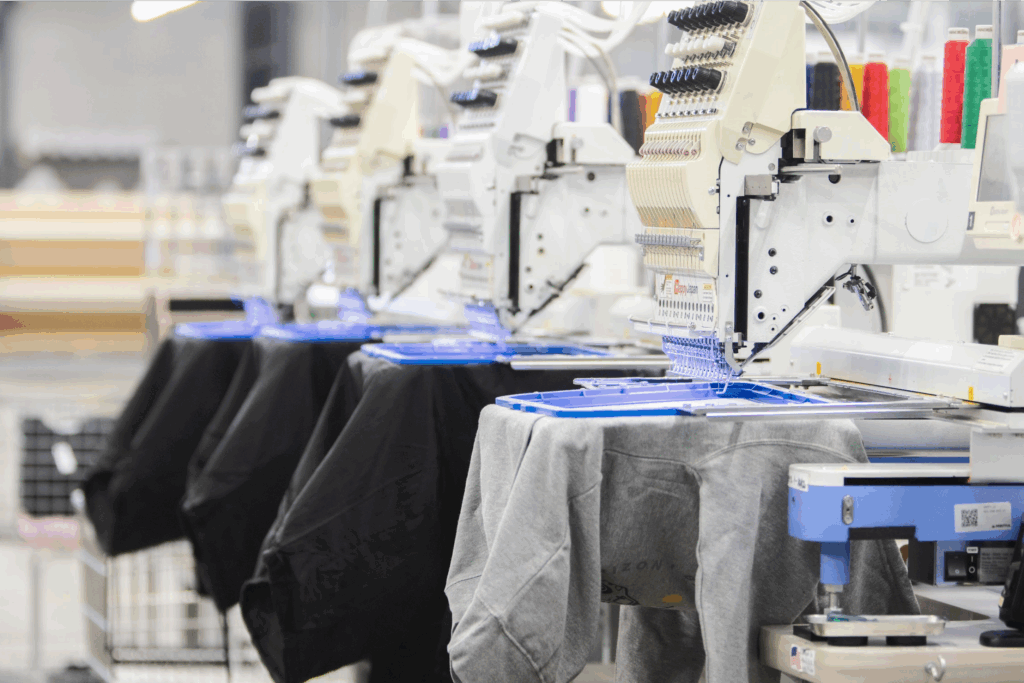Sell custom products without inventory
Want to run an online store without boxes piling up with unsold stock? Shopify makes it possible for eCommerce businesses to sell without storage space or inventory management.
We’ll show you how to sell on Shopify without inventory using five different fulfillment solutions.
Discover business models that cut upfront costs and speed up shipping to build a profitable online store with less risk and more freedom.
This post may contain affiliate links, which means we may earn a commission if you make a purchase through those links. This comes at no additional cost to you.
How to sell on Shopify without inventory using Print on Demand
The easiest way to sell on Shopify without inventory is with a print-on-demand (POD) business model. You don’t need your own warehouse – suppliers will fulfill orders on your behalf.
Develop a brand
Whatever you decide to sell online, start by building a brand identity that reflects your business idea and product niche, helping you connect with your target market.
A strong brand name also helps online store owners stand out on eCommerce platforms and improve search engine optimization (SEO), improving their store visibility.
When thinking about how to sell on Shopify, take time to brainstorm names, visuals, color schemes, and a brand message that aligns with your goals and product offerings.
Need some inspiration? Try Shopify’s Business Name Generator.
Set up your Shopify store

1. Select a plan. Shopify provides a range of pricing plans to suit different business sizes. Consider your goals, budget, and any specific features you need.
2. Choose your theme. Your store’s theme sets the tone for your print-on-demand dropshipping business. Customize your own eCommerce store by:
- Looking for themes that align with your business style.
- Browsing the Shopify Theme Store for a wide selection of free and paid options.
- Considering responsiveness to support mobile eCommerce buyers, who make up 44.6% of total retail sales.
3. Customize your store’s layout. Your digital storefront is key for creating a persuasive path to purchase. Here’s how to optimize your online store for profit:
- Use Shopify’s intuitive drag-and-drop interface to arrange elements on your website.
- Customize colors, fonts, and imagery to match your brand’s visual identity.
- Add About Us, Contact, and FAQ pages to enhance customer engagement.
- Improve your site for usability with a clear menu structure and breadcrumb navigation.
- Speed up loading times by optimizing images for Shopify.
- Include clear calls to action (CTAs) to drive conversions.
4. Integrate useful apps. Explore the Shopify App Store to improve user experience, integrate marketing solutions, and automate order management processes.
- Find apps for synching print-on-demand products, email marketing integrations, review widgets, advanced analytics reporting, or SEO tools for improving search visibility.
Decide what products to sell

Creating a successful Shopify store begins with thorough market research to decide what products to sell.
This means understanding buyer trends, identifying competitors’ best-selling items, and analyzing consumer preferences.
Narrow down a niche of buyers you want to target – for instance, if you sell clothes for nature lovers, try out floral patterns or environmental slogans.
Partner up with a Print on Demand service
Shopify merchants can find, prepare, and fulfill products by collaborating with a print-on-demand service like Printify, featuring over 1,300 high-quality items ready for your designs.
Choose from a variety of items like apparel or home decor, add your branded designs, and start selling without upfront inventory. Products are made to order and we’ll handle production and shipping, avoiding unsold stock and freeing up your time to grow your store.
Here’s how the POD process works:
- Order. A customer buys from your eCommerce store, and the order details are sent to Printify.
- Print. Our Print Providers will apply your design, inspect the finished item for quality assurance, and begin the packing process.
- Ship. The Print Provider delivers the package directly to the customer and gives an approximate arrival time.
- Profit. You earn based on the sellingpriceyou’ve set, making this a low-risk, high-reward alternative to traditional retail models.
Design your products

Whether you prefer to partner with freelancers or edit pre-made designs, this is the time to let your creativity shine.
If you’re creating from scratch, conceptualize your design idea with graphic design software. Prioritize vector graphics to achieve high-quality visuals, then finalize your custom product using Printify’s free Product Creator:
- Use the drag-and-drop interface to apply designs to product templates.
- Adjust the design placement and scale directly within the mockup dashboard.
- Try the text editor for typography-based designs or overlaying captions and slogans.
- Browse royalty-free images using our Shutterstock integration.
- Find design inspiration by running tests through our AI Image Generator.
Order samples to check if the final result meets your design and quality expectations.
When using premade assets, review the terms for commercial use to avoid copyright issues.
Connect your store and publish products
Now, it’s time to integrate Printify with your Shopify store, sync your listings, and start selling without inventory.
Publish your designs by heading to the My products page on your Printify dashboard.
Then, set up delivery options by choosing Automatically assign a new shipping profile. This will match the shipping rates to what you’re charged for fulfillment.
How it works:
- Automatic shipping profile assignment. The system either creates a new shipping profile for your product or assigns an existing one with matching settings.
- Consistency across products. If you’ve previously set up a product like Bella+Canvas 3001 with an automatic shipping profile, Printify will use the same one for all future products from the same Print Provider.
- Bulk and individual publishing. Publish shipping rates in bulk through the My Products page on Printify or by selecting a product and editing its shipping settings manually.
Remember to communicate the shipping process to your customers. Include detailed information about delivery times, shipping costs, and potential delays.
Price products and optimize listings

Pricing your products for success is about balancing competitiveness and profit margins.
Consider these strategies when pricing your items:
- Competitive pricing. Research other stores’ rates for similar products. Shopify’s Help Center can provide insights into standard pricing structures within your niche.
- Profit margin calculation. Analyze the overheads and expenses involved in creating and selling your product, including any online business subscriptions and fees.
Tools like Printify’s t-shirt pricing calculator can help you determine a price that balances costs and profits.
The next step is optimizing your product listings. Make them appealing to shoppers by describing the products in detail to improve visibility for more clicks and sales.
- Listing descriptions. Write compelling product descriptions by including key features and benefits.
- Use keywords. Use tools like Google Keyword Planner or Semrush for keyword research, then incorporate them naturally into product titles and descriptions.
- Product images. Upload high-quality images to attract customers. Take your own photos using samples or use Printify’s Product Creator or PlaceIt to generate beautiful product mockups.
Promote your store

Effective and active promotion is the best way to increase your store’s visibility and drive sales.
Before investing in paid promotions, focus on how to make money on Shopify with no money. Let’s take a deeper look into various digital marketing strategies to successfully sell online.
1. Social media marketing. Use platforms like Facebook, Instagram, Twitter, TikTok, and Pinterest to strengthen your brand messaging and reach potential customers:
- Create engaging posts showcasing your online store and products.
- Use paid targeted ads to reach a specific demographic.
- Engage with your followers to build a community around your brand.
2. Content marketing. Provide your audience with valuable content to bring in more traffic. This establishes your brand as an authority and fosters loyalty with potential customers:
- Start a blog related to your niche to improve your Shopify SEO rankings.
- Use storytelling to connect with your audience by sharing your brand’s journey.
- Offer how-to guides or sell access to exclusive content related to your niche.
3. Email marketing. Build an email list and regularly send out newsletters to keep your customers engaged:
- Send new product announcements, exclusive deals, and promotions.
- Use automation tools to deliver welcome and thank-you emails to new subscribers.
- Manage post-purchase emails to inform the customer about their order status.
- Reduce cart abandonment by reminding shoppers to complete their purchases.
4. Influencer partnerships. Find influencers in your niche to tap into their established audience. Use paid collaborations to present your products through someone shoppers already trust:
- Identify influencers whose followers match your target demographic.
- Work with creators to develop sponsored content and get it shared on their platform.
- Consider promotional deals and design collaborations with influencers.
Gather customer feedback
Encourage customers to leave reviews. Browse the Shopify App Store for tools like Powerful Contact Form Builder or Trustify to make gathering feedback seamless.
Consider their suggestions for improvement and use the insights to refine your product range and enhance the customer experience.
Foster repeat purchases by rewarding loyal customers and prioritizing customer-centric shop policies, like hassle-free returns and fast response times. Identify your bestsellers and cash in on trending items for more sales and better profits.
Other business models for selling without inventory

Dropshipping
The dropshipping business model involves selling products that are produced, stored, packed, and shipped by a third-party supplier.
Unlike a print-on-demand service, the dropshipping supplier offers ready-made products without customization, meaning you’re missing out on branding opportunities.
As a dropshipping business store owner, you don’t keep the products in stock – only sell them. Your dropshipping supplier will process orders and ship the products directly to customers.
Learn more about Shopify dropshipping.
Third-party fulfillment centers
Using third-party fulfillment centers involves storing products in a warehouse managed by another company. This lets you produce products yourself without managing inventory.
They also take care of packing and shipping on your behalf. This model lets you sell on Shopify without handling logistics, freeing up your time for product development and marketing strategies.
Selling digital products
Selling digital products means offering non-physical items like eBooks, online courses, software, audio, video files, and digital art.
Unlike physical products, customers can purchase and immediately receive these items online, eliminating the need for physical inventory, storage, or shipping.
Find out how to sell digital products on Shopify – product ideas included!
Selling affiliate products
In affiliate marketing, you promote other companies’ products or services on your platform, like a Shopify blog. With this online business model, you get paid when a customer clicks and purchases through your affiliate links.
Selling affiliate products doesn’t require inventory management. Simply direct customers to the affiliate products, and your affiliate partners pay you a commission for generating sales.
Why choose Printify for your eCommerce business?

High-quality products
Customize quality physical products like t-shirts, hoodies, and tech accessories and start selling on your own online store.
Beginner-friendly
Our intuitive interface, centralized platform, and 24/7 support simplify operations, even if you have no prior experience.
Reliable suppliers worldwide
Don’t worry about finding reliable suppliers – Printify has a vast global network of vetted Print Providers, featuring the best suppliers Print on Demand has to offer.
Free design tool
Our Product Creator has easy-to-use features and integrations that let you create unique designs without third-party apps. Design and start selling products online with no upfront costs.
Automated order fulfillment
Our system takes the hassle out of order processing. From printing to shipping, Printify handles it all automatically so you can focus on growing your Shopify store.
Conclusion
Sell your own custom merchandise with Print on Demand, dropship products, or even sell digital items – there are plenty of ways to discover how to sell on Shopify without managing inventory.
Focus on finding reliable suppliers or other third-party fulfillment solutions to automate your Shopify online store operations and streamline your eCommerce business.
Want to start for free? Use Printify to sell on Shopify without inventory management. Whether you’re launching a new online business idea or expanding your existing store, our reliable print-on-demand network has your back.












